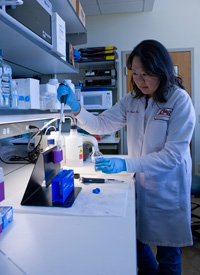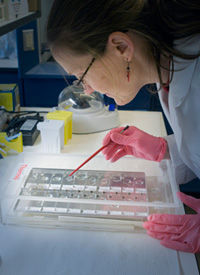
All jawed vertebrates have similar fundamental tools that allow them to generate an adaptive immune response marked by high molecular specificity for antigen and a memory response to previous challenges. Multiple isotypes of antibody heavy and light chains, αβ and γδ T cell receptors, a major histocompatibility complex that is both polygenic and polymorphic, and genetic diversification of antigen receptors via recombination activating gene mediated (RAG) rearrangement and activation-induced cytodine deaminase (AID) function all appear to have evolved half a billion years ago in the cartilaginous fish.We investigate how the adaptive system was built upon the extant innate system at the molecular, cellular, tissue, organismal and population levels. Mike and others talk about our genomic approaches here at Texas A&M in this short video. We’ve also applied transcriptomics to farmed shrimp, and made these resources available to the research and aquaculture communities.

Much of our work employs either the nurse shark Ginglymostoma cirratum or the frog Xenopus laevis as model vertebrate immune systems to experiment within. The nurse shark is representative of the oldest group that shares the adaptive immune system found in man, and the frog represents the first tier in evolution where class switch between immunoglobulin heavy chain isotypes is seen. We rely upon molecular biology and immunogenetics, immunization studies employing thymectomized frogs, PCR, tissue analysis by immunohistochemistry and in situ hybridization, blotting, immune repertoire analysis, ELISA, and cell sorting. We also take advantage of the ever-growing macromolecular databases to inform our wet-bench experiments and test hypotheses in silico whenever possible.
Our goals are bipartite, but related. Our first aim is to understand the evolution of our immune system: its genesis, subsequent natural history, and trajectory into the future. We pursue this using the comparative method focusing on poikilothermic vertebrates. This work allows us to distinguish what aspects are phylogenetically fundamental in our own system and differentiate those that are merely accessory. Our second aim is to continue to discover and understand the many diverse tools less-studied organisms have evolved in their defensive batteries, which mouse and man often lack. These novel receptors, mechanisms, domains and tissue architectures will inform better vaccine development, biomedical engineering and clinical intervention for the better health of all animals.
